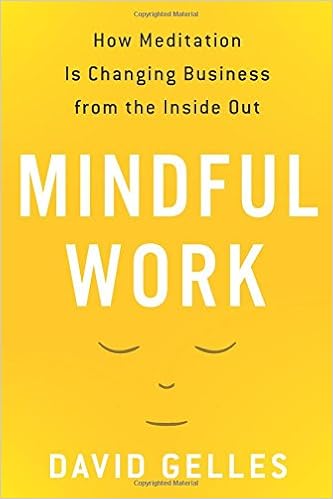The Definitive Guide To Meditation At Work
Learn the history of meditation at work, how to bring meditation into the workplace and why it is so desperately needed.
The History of Meditation At Work
Mindfulness meditation, a practice once associated with mountaintops, sitting still for hours and small, stacked rocks (not sure where that one came from??), has entered mainstream watercooler talk.
How did this happen?
1975
In the Western world, meditation and its benefits on the human body — for example, reduced blood pressure and heart rate — have been well documented from as early as 1975.
The pioneer of scientific research on meditation, Herbert Benson, helped demystify meditation by calling it a “relaxation response.” An easier concept to wrap your head around, the relaxation response can be thought of as a counter to the “fight or flight” response.
Despite not being able to punch my way out of a paper bag, my body sure seems to think it’s about to fight or fly a lot.
Benson’s contribution to the science of mindfulness meditation helped to build the groundwork for researchers and practitioners to come.
“The mind and body communicate constantly. What the mind thinks, perceives, and experiences is sent from our brain to the rest of the body.” – Herbert Benson
1980s
Around the same time, in 1979, Jon Kabat-Zinn created the Mindfulness-Based Stress Reduction (MBSR) curriculum at the University of Massachusetts. This program, originally created to treat the chronically ill, sparked the application of mindfulness training in Medicine for the treatment of a variety of conditions.
Today, MBSR is arguably one of the most widely practiced mindfulness-based programs.
Since the prerequisite to joining an MBSR class is simply the desire to reduce stress, the applications of the program are so applicable to the human condition that anyone can learn from it.
A sister of MBSR, Mindfulness-Based Cognitive Therapy (MBCT), has a smaller application but can be used as a supplement to traditional therapy for those struggling with mental illness. MBCT was one of the first ways I was personally introduced to mindfulness meditation.
Since the late 70s, interest and buzz around mindfulness has truly skyrocketed.
2000s
What started as a small group of researchers, based almost entirely in the United States, has since exploded across academic disciplines, cultures and countries. A quick glance at Google searches from Jan 1, 2004 to today shows an undeniable trend.
2010 – 2015
Within these years, some major international companies started to pilot their first mindfulness programs onsite. Notable examples include General Mills, Goldman Sachs, Target and Aetna.
General Mills started to report very favorable results from their program. “[General Mills] has even begun research into its efficacy, and the early results are striking.
After one of Marturano’s seven-week courses, 83 per cent of participants said they were “taking time each day to optimise my personal productivity” – up from 23 per cent before the course.
Eighty-two per cent said they now make time to eliminate tasks with limited productivity value – up from 32 per cent before the course.
And among senior executives who took the course, 80 per cent reported a positive change in their ability to make better decisions, while 89 per cent said they became better listeners.”
These results triumphed over traditional stress reduction programming with the added benefit of very low implementation costs.
Companies large and small began to take note and mindfulness at work initiatives became increasingly popular.
2015
Around 2015 we saw the dramatic rise of the self-directed guided meditation app. Early adopters and the meditation-curious swarmed towards these low-cost, accessible guided meditations that you could carry around in your pocket. This actually aligned nicely with my nervous breakdown (we didn’t even plan it!) and I tried out about a half-dozen of the apps myself as a part of my mindfulness-based cognitive therapy (MBCT).
One of the big players in the space. Calm, was named the 2017 iPhone app of the year by Apple itself. Headspace and Simple Habit were also garnering the attention of CEOs, celebs and academics.
However, hype is often fleeting and may have led some to believe that mindfulness meditation was yet another kale-juice-pokemon-go-planking-like fad.
The question boiled down to: is this something people truly want and need. In one swift press release, Calm answered the question with a resounding “yes!” by announcing an $88 million Series B funding round — boosting its valuation to over $1 billion, making it tech’s first “unicorn” focused on meditation.
Coming from a background software and the startup world, whenever a huge valuation is announced the question is: but is it something people will pay for?
Which is when Calm lowkey announced they have hit over 40 million downloads worldwide (more than the population of all of Canada!), with one new user joining every second.
The app also has over one million paid subscribers.
As an in-person mindfulness teacher, I could not be happier to see these companies, even in the tech world, skyrocket to a critical mass of users.
The same year, 2015, David Gelles publishes one of the first books specific to mindfulness at work.
It is a great read and was the first time I learned about the practical workplace applications of mindfulness.
It was also news to me at the time, just how many companies were already implementing mindfulness meditation into their workplace.
The laundry list included many companies you may have heard of such as, Google, Adobe, General Mills, Goldman Sachs and Apple… like, APPLE, APPLE! THE APPLE. GOLDMAN SACHS. THE GOLDMAN SACHS.
I was so fascinated by the growing rumbling of workplace meditation.
When asked, “What did you find most surprising while writing the book?”
David answered,
“The growing mainstream acceptance of meditation and mindfulness continues to amaze me. In just a few years, what was once a fringe movement has become an accepted line of research for academics and scientists, a valid treatment for soldiers and sick patients, and a reliable performance enhancer for groups such as the Boston Red Sox and the U.S. Marines. And it’s just getting started.”
Now, the year is 2015 – I’m sure you’re wondering, but Kayla, what were you doing then? I’m glad you asked!
I was smack dab in the middle of a nervous breakdown. What feels like a lifetime ago, in 2015, I had landed in a depressive episode that would have me off work for almost an entire year.
2019
After returning to work in the tech world full-time, for four years, I knew in my gut (plus some data-backed research helped) that the demand for workplace mindfulness programming would soon outpace the supply.
I sought out as much formal training as possible: Google’s Search Inside Yourself training, the University of Toronto’s Foundations of Applied Mindfulness Meditation Certificate, Mindfulness Without Borders, and both MBCT and MBSR at the Centre for Mindfulness Studies.
I quit my job in the hectic tech world and jumped into the hectic world of entrepreneurship.
Today
Today, mindfulness meditation has hit the mainstream. The idea of talking about meditation around the watercooler is not so far fetched and global management consulting firms are reporting on the benefits of mindfulness training.
Today, my company, Twello, offers workplace mindfulness training across Canada and the United States.
Our team is growing and expanding our reach, with the mission of becoming watercooler material in the next two years.
Thank you for following along! If you are reading this and wondering if there is a space for you in the workplace mindfulness world, I am telling you, the answer is unequivocally, “YES.”
10 Reasons Why Meditation At Work Is So Effective For Organizations
Meditation in the workplace has gone mainstream.
Corporate mindfulness training, 1:1 Executive coaching, lunch & learns and morning meditation classes are only one google search away.
Anecdotally, we know that a less stressful workplace leads to improved morale, increased productivity and fewer stress-related absences.
But what does the data say?
Get ready for a lot of #science in this post. We don’t always have an opportunity to list our ten favourite meditation stats, but this seemed like a great place to do it!
Here are ten compelling benefits of mindfulness meditation in the workplace:
- Meditation Improves Focus: Research has shown that meditation leads to changes in the brain region involved in learning and memory. Employees who practice meditation at work are able to stay on task, manage time and make wise work-related decisions with ease.
- Meditation Decreases Stress: It has been conservatively estimated that organizations lose $602 (USD) per year, per employee to stress-related estimates. It has been proven that meditation leads to a reduction in stress. Not only can this help in boosting morale in the workplace, but it can also reduce stress-related symptoms that can lead to serious chronic illnesses. Employees can enjoy better health and employers can look forward to reduced absences as a result.
- Meditation At Work Strengthens Relationships: Meditation improves mood and increases emotional intelligence (EI). Emotional intelligence is commonly linked to success and leadership within organizations. EI is vital when communicating and collaborating with colleagues.
- Meditation Classes At Work Improve Creativity: Studies have shown that mindfulness meditation works to increase creativity and insight while decreasing cognitive rigidity. Creativity is a key component for problem-solving. Mindful employees find innovative solutions for problems at work. It is no coincidence that organizations with more creative thinkers consistently outperform in their industry.
- Mindfulness-Based Wellness Benefits Increase Employee Loyalty: Organizations who make the effort to provide meditative services or time set aside for meditation are looked on more favourably by employees. Accessible and effective wellness plans improve employee morale and decrease turnover. Recruiting bonus: happy employees are more likely to refer strong candidates for other roles.
- Meditation Classes At Work Are Extremely Accessible for All Employees: A pitfall of many employee wellness plans is they are unable to accommodate all levels of employee wellness. For example, if an employer offers free gym memberships, they may be alienating and frustrating the part of their workforce that cannot go to the gym. Mindfulness meditation training may be the exact opposite of that. Employees can meditate from the comfort of their office chairs with no special equipment or clothing needed.
- Mindfulness Meditation Classes Are A Low-Cost Wellness Benefit: Bringing in an instructor to lead group meditations is a low-cost solution for improving health and wellbeing, especially when compared to bringing in a masseuse or personal trainer.
- Everyone Can Participate In Meditation Classes: One of Twello’s principles is a commitment to secular meditation. Secular meditation means that the practice is not tied to any particular religion or ideology. When mindfulness meditation is taught from a neuroscience perspective, no one has to feel uncomfortable about religious undertones and everyone can participate.
- Mindfulness Meditation Boosts Energy Levels At Work: Meditation relieves you of energy-draining stress. Employees that meditate often cite improved sleep and decreased exhaustion.
- Mindfulness Produces Sustainable Results: While typical health insurance will cover the costs of an illness, they do not treat the core issues including stress, burnout and exhaustion. Meditation at work is a proactive health benefit which means it treats stress before it snowballs into burnout. Mindfulness meditation programming pays off for years to come. Workers are healthier, more productive and feel better about the company they work for.
5 Ways To Bring Mindfulness Meditation to Your Workplace
Ah, the modern workplace—open concept, exposed brick, a ping pong table and crippling occupational stress.
Admittedly, as a society, we haven’t done a great job of bringing our positive mental health into the modern workplace.
Although we’re walking more, smoking less and even have apps on our phone reminding us to drink water, there is still a huge, unaddressed elephant in the boardroom: workplace mental health.
Scary stats about workplace stress and mental health include:
- 48% of workers say they’re at least “sometimes” overwhelmed by their work, 10% said “all the time”
- Direct correlations have been found between perceived stress at work and certain types of cancer, heart disease, obesity, anxiety, depression and diabetes
- It’s estimated that 20% of people in the workforce right now are experiencing some degree of a mental health issue
- 66% of workers have lost sleep due to work-related stress
- Stress, depression and anxiety accounted for 57% of all working days lost in 2018
- Only 43% of workers believe their employers care about work-life balance
So how can you reduce stress in your workplace?
-
Workshops, Seminars and Lunch & Learns
- Workshops, seminars and Lunch & Learns are the easiest way to bring mindfulness training into the office. Many organizations already have personal development days built into their workforce benefits. It is also becoming increasingly popular for organizations, especially enterprise-level to dedicate entire mornings, afternoons or days to wellness initiatives.
- Lunch and learns are also a very popular way to bring a quick overview of mindfulness into the office. This option is a turnkey solution and can be scheduled on short notice. If your company is just dipping its toes into wellness, mental health or mindfulness, this is the most common selection. Lunch and learns almost always lead to the organization bringing in a mindfulness instructor on a more consistent basis or lead to the organization holding the same sessions in other offices and geographies.
-
Daily / Weekly / Monthly Guided Meditation Classes
- This is a great option for organizations that want to ensure they support a sustainable mindful culture within the workplace. Consistent practice is the best way to reap the benefits of the practice.
- Weekly is the most common cadence followed by biweekly, daily and monthly.
- Many people struggle to keep up a regular mindfulness practice at home so this is a great way to bring the practice to them.
-
1:1 Executive Coaching for Mindful Leaders
- You can think of this just like personal training! 1:1 training is extremely effective for custom, personalized practices to address the client’s most pressing issues.
- When working one-on-one allows the facilitator to tweak the content for specialized training.
- This is a great option for individuals who would like to use mindfulness to address specific topics such as: burnout, anxiety, mental health, focus, productivity, occupational stress, emotional intelligence or communication skills
-
Keynote Presentations
- Keynotes are similar to Lunch & Learns but usually take place at company meetings, wellness events or conferences.
- Mindfulness keynotes usually span 30-90 minutes. The speaker can also introduce some mindfulness practices to the audience during the speech which can expand the time slot up to two hours!
- This is a great option for organizations who are looking to fill some gaps in their programming and bring in someone external.
- Interestingly, a great keynote often leads to onsite guided meditation classes and offers a preview of what that instructor has to offer.
- Other traits of a great keynote include humour, the ability to liven up a crowd and to captivate an audience and open their minds to mindfulness meditation.
-
Organizational Mindfulness Consulting and Research
- Of all the formats, consulting and research is the most effective way for an instructor to analyze the company’s current wellness practices and provide custom recommendations for that organization.







